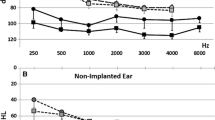Abstract
Preoperative and postoperative bone conduction thresholds were compared in 181 chronic ears operated on over a 5-year period between 1990 to 1994. In the majority (92%) of cases the bone conduction thresholds remained unchanged (± 10 dB). Nine ears (5%) showed better thresholds after surgery, with improvements ranging from 11 dB to 25 dB. This improvement was especially noted in ears with severe tympanic pathology. One ear with a large labyrinthine fistula became totally deaf after surgery. In 5 ears (3%) bone-conduction thresholds deteriorated, but remained measurable at all frequencies tested. In these latter cases this impairment ranged from 11 dB to 27 dB. Cholesteatomatous ears having intact ossicular chains were found to be at the highest risk of inner ear damage when “canal wall-down” mastoidectomies were performed. Methods for prevention of sensorineural hearing loss following chronic ear surgery are discussed.
Similar content being viewed by others
References
Gacek RR (1974) The surgical management of labyrinthine fistulae in chronic otitis media with cholesteatoma. Ann Otol Rhinol Laryngol 83 [Suppl 10]:3–19
Hallmo P, Mair IWS (1996) Drilling in ear surgery. A comparison of pre- and postoperative bone-conduction thresholds in both the conventional and extended high-frequency ranges. Scand Audiol 25:35–38
Helms J (1976) Acoustic trauma from the bone cutting burr. J Laryngol Otol 90:1143–1149
Kylen P, Arlinger S (1976) Drill generated noise levels in ear surgery. Acta Otolaryngol (Stockh) 82:402–409
Ophir D, Porat M, Marshak G (1987) Myringoplasty in the pediatric population. Arch Otolaryngol Head Neck Surg 113:1288–1290
Palva T, Kärjä J, Palva A (1973) High-tone sensorineural losses following chronic ear surgery. Arch Otolaryngol 98:176–178
Smyth GDL (1977) Sensorineural hearing loss in chronic ear surgery. Ann Otol Rhinol Laryngol 86:3–8
Spencer MG, Reid A (1985) Drill-generated noise levels in mastoid surgery. J Laryngol Otol 99:967–972
Tos M, Lau T, Plate S (1984) Sensorineural hearing loss following chronic ear surgery. Ann Otol Rhinol Laryngol 93:403–409
Tos M, Trojaborg N, Thomsen J (1989) The contralateral ear after translabyrinthine removal of acoustic neuromas: is there a drill-noise generated hearing loss? J Laryngol Otol 103:845–849
Urquhart AC, McIntosh WA, Bodenstein NP (1992) Drill-generated sensorineural hearing loss following mastoid surgery. Laryngoscope 102:689–692
Vartiainen E (1992) What is the best method of treatment for labyrinthine fistulae caused by cholesteatoma? Clin Otolaryngol 17:258–260
Author information
Authors and Affiliations
Rights and permissions
About this article
Cite this article
Vartiainen, E., Seppä, J. Results of bone conduction following surgery for chronic ear disease. Eur Arch Otorhinolaryngol 254, 384–386 (1997). https://doi.org/10.1007/BF01642555
Received:
Accepted:
Issue Date:
DOI: https://doi.org/10.1007/BF01642555




